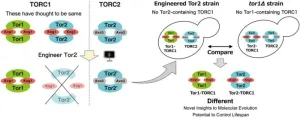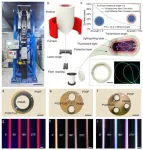(Press-News.org) New findings reveal that the body undergoes significant, systematic changes across multiple organs during prolonged periods of fasting. The results demonstrate evidence of health benefits beyond weight loss, but also show that any potentially health-altering changes appear to occur only after three days without food.
The study, published today in Nature Metabolism, advances our understanding of what’s happening across the body after prolonged periods without food.
By identifying the potential health benefits from fasting and their underlying molecular basis, researchers from Queen Mary University of London’s Precision Healthcare University Research Institute (PHURI) and the Norwegian School of Sports Sciences provide a road map for future research that could lead to therapeutic interventions – including for people that may benefit from fasting but cannot undergo prolonged fasting or fasting-mimicking, such as ketogenic, diets.
Over millennia, humans have developed the ability to survive without food for prolonged periods of time. Fasting is practiced by millions of people throughout the world for different medical and cultural purposes, including health benefits and weight loss. Since ancient times, it has been used to treat diseases such as epilepsy and rheumatoid arthritis.
During fasting, the body changes its source and type of energy, switching from consumed calories to using its own fat stores. However, beyond this change in fuel sources, little is known about how the body responds to prolonged periods without food and any health impacts – beneficial or adverse – this may have. New techniques allowing researchers to measure thousands of proteins circulating in our blood provide the opportunity to systematically study molecular adaptions to fasting in humans in great detail.
Researchers followed 12 healthy volunteers taking part in a seven-day water-only fast. The volunteers were monitored closely on a daily basis to record changes in the levels of around 3,000 proteins in their blood before, during, and after the fast. By identifying which proteins are involved in the body’s response, the researchers could then predict potential health outcomes of prolonged fasting by integrating genetic information from large-scale studies.
As expected, the researchers observed the body switching energy sources – from glucose to fat stored in the body – within the first two or three days of fasting. The volunteers lost an average of 5.7 kg of both fat mass and lean mass. After three days of eating after fasting, the weight stayed off – the loss of lean was almost completely reversed, but the fat mass stayed off.
For the first time, the researchers observed the body undergoing distinct changes in protein levels after about three days of fasting – indicating a whole-body response to complete calorie restriction. Overall, one in three of the proteins measured changed significantly during fasting across all major organs. These changes were consistent across the volunteers, but there were signatures distinctive to fasting that went beyond weight loss, such as changes in proteins that make up the supportive structure for neurons in the brain.
Claudia Langenberg, Director of Queen Mary’s Precision Health University Research Institute (PHURI), said:
“For the first time, we’re able to see what’s happening on a molecular level across the body when we fast. Fasting, when done safely, is an effective weight loss intervention. Popular diets that incorporate fasting – such as intermittent fasting – claim to have health benefits beyond weight loss. Our results provide evidence for the health benefits of fasting beyond weight loss, but these were only visible after three days of total caloric restriction – later than we previously thought.”
Maik Pietzner, Health Data Chair of PHURI and co-lead of the Computational Medicine Group at Berlin Institute of Health at Charité, said:
“Our findings have provided a basis for some age-old knowledge as to why fasting is used for certain conditions. While fasting may be beneficial for treating some conditions, often times, fasting won’t be an option to patients suffering from ill health. We hope that these findings can provide information about why fasting is beneficial in certain cases, which can then be used to develop treatments that patients are able to do.”
NOTES TO EDITORS
For more information, please contact:
Honey Lucas
Faculty Communications Officer – Medicine and Dentistry
Queen Mary University of London
Email: h.lucas@qmul.ac.uk
Paper details: ‘Systemic proteome adaptions to 7-day complete caloric restriction in humans’ will be published in Nature Metabolism on 10.00 am GMT 1 March 2024.
DOI: 10.1038/s42255-024-01008-9
Paper available upon request.
Available after publication at the following URL: https://www.nature.com/articles/s42255-024-01008-9.
About the Precision Healthcare University Research Institute (PHURI)
Through world-class multidisciplinary research and innovation, the Precision Healthcare University Research Institute (PHURI) is driving a new era of personalised healthcare in East London to address unmet health needs, tackle health inequalities and improve lives in our local community and across the world.
About Queen Mary University of London
At Queen Mary University of London, we believe that a diversity of ideas helps us achieve the previously unthinkable.
Throughout our history, we’ve fostered social justice and improved lives through academic excellence. And we continue to live and breathe this spirit today, not because it’s simply ‘the right thing to do’ but for what it helps us achieve and the intellectual brilliance it delivers.
Our reformer heritage informs our conviction that great ideas can and should come from anywhere. It’s an approach that has brought results across the globe, from the communities of east London to the favelas of Rio de Janeiro.
We continue to embrace diversity of thought and opinion in everything we do, in the belief that when views collide, disciplines interact, and perspectives intersect, truly original thought takes form.
About the Berlin Institute of Health at Charité (BIH)
The mission of the Berlin Institute of Health at Charité (BIH) is medical translation: transferring biomedical research findings into novel approaches to personalized prediction, prevention, diagnostics and therapies and, conversely, using clinical observations to develop new research ideas. The aim is to deliver relevant medical benefits to patients and the population at large. As the translational research unit within Charité, the BIH is also committed to establishing a comprehensive translational ecosystem – one that places emphasis on a system-wide understanding of health and disease and that promotes change in the biomedical translational research culture. The BIH was founded in 2013 and is funded 90 percent by the Federal Ministry of Education and Research (BMBF) and 10 percent by the State of Berlin. The founding institutions, Charité – Universitätsmedizin Berlin and Max Delbrück Center, were independent member entities within the BIH until 2020. Since 2021 the BIH has been integrated into Charité as its so-called third pillar. The Max Delbrück Center is now the Privileged Partner of the BIH.
END
Study identifies multi-organ response to seven days without food
2024-03-01
ELSE PRESS RELEASES FROM THIS DATE:
New microbiome insights could help boost immunotherapy for a range of rare cancers
2024-03-01
The microbiome can identify those who benefit from combination immunotherapy across multiple different cancers, including rare gynaecological cancers, biliary tract cancers and melanoma.
Researchers from the Wellcome Sanger Institute, the Olivia Newton-John Cancer Research Institute in Australia, and collaborators, have identified specific strains of bacteria that are linked with a positive response to combination immunotherapy in the largest study of its kind.
The study, published today (1 March) in Nature Medicine, details a signature collection of microorganisms in an individual’s gut bacteria that may help identify those who would benefit from combination immunotherapy and ...
It’s not only opposites that attract – new study shows like-charged particles can come together
2024-03-01
A study published today in Nature Nanotechnology shows that similarly charged particles can sometimes attract, rather than repel.
The team found that like-charged particles suspended in liquids can attract one another at long-range, depending on the solvent and the sign of the charge.
The study has immediate implications for processes that involve interactions in solution across various length-scales, including self-assembly, crystallisation, and phase separation.
‘Opposites charges attract; like charges repel’ is a fundamental principle of basic physics. But a new study from Oxford University, published today in Nature Nanotechnology, has demonstrated that similarly ...
Japanese wolves are most closely related to dogs and share DNA with East Eurasian dogs
2024-03-01
In this study, we determined nine genomes of Japanese wolves and 11 genomes of modern Japanese dogs at high coverage and analyzed with one hundred dog and wolf genomes in the public database. The analyses showed that 1) the Japanese wolf was a unique subspecies of the gray wolf that is genetically distinct from both extant and ancient gray wolves known to date, 2) the Japanese wolf is most closely related to the monophyletic group of dogs. Furthermore, 3) Japanese wolf ancestry has introgressed into the ancestor of East Eurasian dogs at an early stage of the dog’s history ...
Brown bears digging up artificial forests
2024-03-01
Brown bears foraging for food in the Shiretoko Peninsula of Hokkaido, Japan, have been disrupting tree growth in artificial conifer forests, according to a new study. Researchers compared soil and tree samples from human-forested plots with samples from natural forests. They found that the bears’ digging for cicada nymphs damaged tree roots and altered the nitrogen content of the soil, which in turn limited the diameter growth of trees. The phenomena of bears digging for cicadas, an unusual food source, appears to be restricted to human-planted conifer forest; diversely vegetated natural forest ...
Innovative domain-adaptive method enables 3D face reconstruction from single depth images
2024-03-01
Reconstructing a 3D face from visuals is crucial for digital face modeling and manipulation. Traditional methods predominantly depend on RGB images, which are susceptible to lighting variations and offer only 2D information. In contrast, depth images, resistant to lighting changes, directly capture 3D data, offering a potential solution for robust reconstructions. Recent studies have turned to deep learning for more robust reconstruction from depth data; however, the scarcity of real depth images with accurate 3D facial labels has hindered the training process. Attempts to use auto-synthesized data for training have met limitations ...
Groundbreaking study unveils unique roles of yeast protein complexes in cellular lifespan and environmental response by rationally engineering based on the predicted three-dimensional structures
2024-03-01
Assistant Professor Takahiro Kosugi of Institute for Molecular Science, assistant Professor Yoshiaki Kamada at National Institute for Basic Biology, and colleagues have developed an advanced molecular cell biology approach by integrating computational redesigning of protein complexes based on the predicted three-dimensional structure into yeast genetics. They revealed that two types of protein complexes in yeast, which were thought to have the same function, play distinct roles in cellular environmental response and lifespan. Furthermore, ...
Mass-produced, commercial promising multicolored photochromic fiber
2024-03-01
Fiber, as the wearable material with the longest application in the history of humankind, is currently an ideal substrate for wearable devices due to its excellent breathability, flexibility, and ability to adapt perfectly to the 3D irregular shape of the human body. As a means of visualization in the field of functional fibers, light-emitting fiber breaks the rigidity of the traditional display interface and is expected to become an emerging interaction interface. The current commercial light-emitting fibers are polymer optical fibers and Corning® Fibrance® light-diffusing fibers. These fibers ...
General Medical Council urged to revise terminology for international medical graduates
2024-03-01
The General Medical Council (GMC) should revise its terminology regarding international medical graduates (IMGs) in the UK, argues a new commentary published in the Journal of the Royal Society of Medicine (JRSM).
The existing terminology used by the GMC fails to encompass the full spectrum of doctors facing challenges in the UK medical workforce, according to the paper’s author, Professor Mo Al-Haddad of Queen Elizabeth University Hospital, Glasgow.
Notably, he says, the GMC's definition of IMGs overlooks ...
Prostate cancer test may lead to harmful overdiagnosis in black men
2024-03-01
A new study from experts at the University of Exeter has found that a widely used test for prostate cancer may leave black men at increased risk of overdiagnosis.
Prostate-specific antigen (PSA) testing is routinely used as the first step in the UK to investigate men with urinary symptoms such as blood in urine or urinating very frequently. Men aged over 50 years without symptoms are also able to request the blood test from their GP.
The new study, published in BMC Medicine, sought to investigate the performance of the PSA test in identifying prostate cancer among men ...
Discovery of proteins associated with the progression of dialysis-related amyloidosis
2024-03-01
Niigata, Japan –Dialysis patients often develop dialysis-related amyloidosis and exhibit bone and joint disorders that impair their activity of daily living (Figure 1). Blood purification devices consisting of hexadecyl-immobilized cellulose beads aimed at removing the precursor protein, β2- microglobulin (β2-m), are used in the treatment of dialysis-related amyloidosis. Dr. Yamamoto et al. investigated that comprehensive analysis of proteins adsorbed onto blood purification devices revealed the identification of 200 types of proteins, including β2-m. ...






